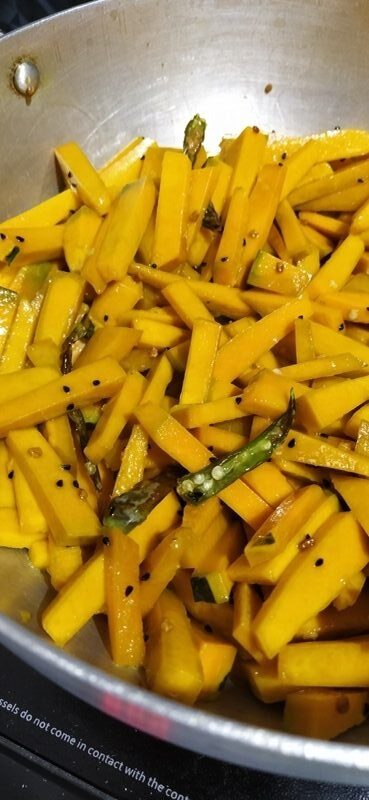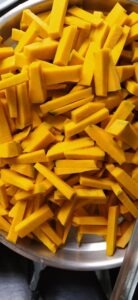About The Author
Hello! From Chuchura (in Hooghly District) and a foodie, I created this blog with a mission to preserve the food of the land; with a message to encourage and promote clean and real food. I hope you enjoy and gain out of this blog, happy reading!
Looking forward to read and hear your feedback.
Talk of chechki and the first dish that comes to everyone’s mind is kumro chechki – a chechki made from pumpkins.
But chechki should not necessarily always be made from pumpkin, it can be prepared from a multitude of vegetables and even fish!
This is not just a recipe blog on kumro chechki or pumpkin chechki. It is a deep dive into the humble and simple world of whipping up a delicious chechki.
Don’t have time for the basics?
Jump to RecipeIn Bengal there is no single way of cooking a chechki.
There are regional variants.
In the olden times, people cooked fresh and used locally available ingredients, a luxury we can seldom afford today.
This ensured that there are small improvisations in the ingredients used. Simple improvisations that bring noticeable changes to the taste of the dish.
A chechki can be cooked in either the Barendra style or the Rarh Banga style
FinallyFoodie.com Food FactTweet
In this post, we have covered both the styles while the detailing has been shared for Barendra style kumro chechki.
If you are interested in cooking the Rarh Banga style as well, we have provided inputs and called out the differences.
What Is A Chechki?
Chechki is a dish where vegetables or fish or both are cut into smaller pieces and sautéed in oil tempered using slit green chilis, fenugreek seeds (methi) or mustard seeds (depending on the region), followed by cooking in sufficient water till the vegetable or fish is well done.
In Barendra style chechki, fenugreek seeds are used for tempering.
Rarh Banga style kumro chechki does not use fenugreek seeds, but instead uses brown/black mustard seeds.
The end result is a dry dish where the vegetable is well done and it just manages to hold on to its form.
The Basics of Chechki – Important to Get Your Pumpkin Chechki Correct
Cooking a chechki is easy, knowing the basics will make your life easier in cooking a variety of chechki.
The Oil
Mustard oil is non-negotiable ingredient in cooking a chechki.
The chechki requires less amount of oil. For example, the amount of oil used in cooking a chechki is lot lesser than the amount of oil used in cooking a bhaja (stir fry).
Talking of a Bengali bhaja, it is important to understand the difference between a chechki and a bhaja.
Remember! Mustard oil is healthier than the regular white oil. Never use olive oil to cook Bengali cuisine. Here’s why you must make a healthy oil choice!
Difference Between a Bhaja and Chechki
The basics of a chechki can be easily and properly understood when compared to its cousin – the Bengali bhaja.
Tempering the Dish
A bhaja or stir fry does not need tempering with whole spices.
In a chechki, the oil is always tempered. While fenugreek seeds (methi) and slit green chilies are used as a mandate, sometimes nigella seeds (kalo jeere) are also added.
In the kumro chechki (cooked in Barendra style), the tempering used is slit green chilies, fenugreek or mustard seeds and nigella seeds.

Nature of Veggies Used in a Chechki and Bhaja
In the 21st century, most Bengalis use any sort of vegetables for cooking anything. This shows lack of knowledge and disrespect to the cuisine.
In a bhaja, tender vegetables are always used. In a chechki, older or ripened veggies are used.
Size of Chopped Vegetables – How to Size Your Pumpkin for Kumro Chechki?
The size of chopped veggies in a chechki is always smaller than that of a stir fry or bhaja.
Indeed the name chechki comes from the Bengali word ‘checha’ which means to chop finely. Note that finely chopped veggies does not imply you will mince your vegetables.
Amount of Water Used
In a bhaja, the idea is always to use no or minimum water. Water is splashed in the wok to avoid the vegetables from sticking to the bottom of the pan and getting burnt.
On the other hand, in a chechki like pumpkin chechki, water is used to ensure that the vegetables are cooked properly.
Care is taken to ensure that the water is dried up completely when the vegetables are cooked.
This is important, since lack of experience can lead to water left in the pan even after the vegetables have completely cooked.
In an effort to dry the water, the veggies may even get mashed which is not a welcome outcome.
Can I Use Panch Phoron in My Chechki?
Chechki is a very commonly cooked dish from the Barendra region of Bengal.
No Panch Phoron!
In Barendra, panch phoron or the Bengali 5-spice is not used in cooking and hence a traditional chechki recipe does not use panch phoron.
In Rarh Banga style of cooking a kumro chechki, panch phoron is used very sparingly and instead mustard seeds are mostly used.
How is a Bengali Jhol Different From a Chechki?
While the tempering used in a Bengali jhol is same as that of a chechki, there are two important differences to note.
Nature of Vegetables and Size
In a chechki, older and ripe vegetables are chopped into finely small pieces.
While for a jhol, relatively tender vegetables are used and they are chopped in bigger pieces.
Content of Liquid Gravy
In a Bengali jhol, the dish has a gravy of light consistency while a chechki is a dry dish with no gravy.
Debunking Some Modern Recipes – Save the Bengali Kumro Chechki
Thanks to YouTube, I have been unlucky enough to witness a lot of chechki recipes that are far away from a traditional recipe.
And hence as a Bengali, I thought it is my responsibility to dispel some of these recipes. Let’s cook a real chechki like it was prepared for decades and centuries.
- Ginger and garlic are never used in a chechki
- The only spice powder used is turmeric. Cumin and coriander powder are not used
- Tomatoes may be a mandatory ingredient in every gravy you see on YouTube, but tomatoes are never used in a chechki. Not unless you want to cook a tomato chechki. Wait? I never heard of tomato chechki!
- No garam masala please, the soul of this dish lies in its simplicity and humble use of ingredients
- Chechki tends to be sweeter and hence sugar is generally added
To summarize, the differences between a Rarh Banga style and Barendra style cooked chechki are mentioned below
- Barendra style chechki uses fenugreek (methi) seeds, while Rarh Banga style uses whole black/brown mustard seeds
- The dish at Barendra is made sweeter by adding sugar, while Rarh Banga style does not cook it sweet
- Rarh style uses water sparingly while cooking a chechki, while adding water to cook the vegetables is a norm in Barendra style kumro chechki
Armed with these basics, get ready to whip up a Bengali kumro chechki!

Note
The equipment & ingredient quantity provided in this recipe is to assist you in cooking this dish. Feel free to experiment with your ingredients. Remember that we all have different set, size & shape of kitchen tools in our pantry.
Equipment
- 1 Knife and chopping board or use the humble "bonti"
- 1 Wok and spatula
- Serving Bowls
Ingredients
- 500 g pumpkin red pumpkin is preferable for kumro chechki
- 2 tsp mustard oil
- 2 pc green chili
- 1/2 tsp whole methi
- 1/2 tsp nigella seeds (kalojeere)
- 1/3 tsp turmeric powder
- 2 tsp sugar
- salt to taste
Instructions
- Cut the pumpkin in thin slices as shown in the picture. Alternatively you can also chop them in small cubes

- Slit the green chilis and keep aside
- Put a wok and switch on the flame. Ensure that the flame is on medium
- Add mustard oil and allow the oil to smoke
- When the oil smokes, add in the slit green chilis
- Immediately also add in the nigella (kalojeere) seeds and whole methi
- Stir for a few seconds and add in the pumpkin
- Give this a nice stir for a minute
- Add turmeric powder, salt and sugar
- Add in half a cup of water and allow to cook until the pumpkin is well done
- Check for seasonings and adjust if needed
- Give the whole kumro chechki a nice stir
- Switch off the flame
- Serve hot with rice or luchi
Notes
- You can keep the skin on if your pumpkin is home grown
- Red chilies are never used for cooking a chechki
- The steps and ingredients used in this recipe follows the Barendra style of chechki cooking. If you are interested in the Rarh style of kumro chechki, the differences are covered above


Very authentic and yet touching way to convey to readers the recipe. My mother would cook the above dish very well. She is no more but this recipe is like how ma would do. Thanks a lot genuinely.
Pingback: Chorchori - Diving Deep into the Humble & Flavorful Bengali Medley